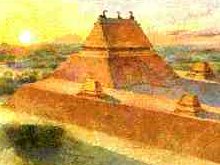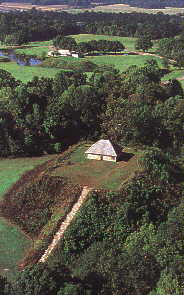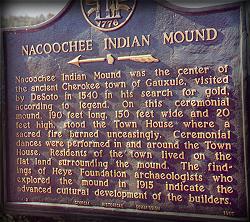|
|
Mound Builders


In N American archaeology, name given to those people who built mounds in a large area from the Great Lakes to the Gulf of Mexico and from the Mississippi River to the Appalachian Mts. The greatest concentrations of mounds are found in the Mississippi and Ohio valleys. Although the name mound builders implies homogeneity, most archaeologists hold that they were not connected politically. Economically, however, they were similarsedentary farmers who lived in permanent villages. It is also believed that they were the ancestors of the Native Americans found inhabiting the regions of the mounds by the first European explorers. Due to locality and tribal customs there is much variation in the shape, size, and purpose of mounds. Shapes include conical tumuli, elongated or wall-like mounds, pyramidal mounds, and effigy mounds (bird, animal, or serpentine forms). In size they vary from less than one acre (.4 hectares) in area to more than 100 acres (40 hectares). The Cahokia Mound in Illinois is the largest; it is about 1,000 ft (300 m) from north to south, 700 ft (210 m) from east to west, and 100 ft (30 m) high. The mounds were used chiefly as burial places but also as foundations for buildings (e.g., temples), as fortresses (e.g., Fort Ancient in Ohio), and as totemic representations (e.g., Serpent Mound in Ohio and Elephant Mound in Wisconsin). Mounds also vary in age; some date back as far as the early part of the 6th cent., while others (particularly in the southeastern area) were built in historic times. Stone, copper, mica, obsidian, and meteoric iron were widely used by the prehistoric mound builders. Obsidian coming from the Rocky Mts., mica from the S Appalachian Mts., and copper from Wisconsin indicate widespread trade. The people practiced weaving and pottery making. Their stone carvings of animal and human figures and especially of pipes are excellent. The mounds at Hopewell, Mound City, and Newark in Ohio, as well as many in Louisiana, Illinois, Indiana, Wisconsin, and Iowa, have been extensively studied. See Robert Silverberg, Mound Builders of Ancient America (1968).

Nacoochee Indian Mound was the center of the ancient Cherokee town of Gauxule, visited by DeSoto in 1540 in his search for gold, according to the legend. On this ceremonial mound, 190 feet long, 150 feet wide and 20 feet high, stood the Town House where a sacred fire burned unceasingly. Ceremonial dances were performed in and around the Town House. Residents of the town lived on the flat land surrounding the mound. The findings of Heye Foundation archaeologists who explored the mound in 1915 indicate the advanced cultural development of the builders.
Ancient Architects of the Mississippi - http://www.cr.nps.gov/aad/feature/feature.htm
Article about the earthworks of the Mississippian "moundbuilders."
Mississippian Moundbuilders And Their Artifacts - http://www.mississippian-artifacts.com/
Image gallery of Mississippian pottery, pipes, jewelry, beads, and other artifacts.
Moundbuilders: North Georgia's Early Inhabitants - http://ngeorgia.com/history/early.html
Brief history of the Mississippian culture and the Etowah Indian Mounds.
Oneota - http://www.angelfire.com/wi/oneota/
Massive bibliography of Oneota-related texts and websites.
The American Indian in Tennessee - http://mcclungmuseum.utk.edu/permex/archaeol/archaeol.htm
Traces the last 15,000 years of Native American occupation of Tennessee, using artifacts from the McClung Museum's collections. Includes the Duck River Cache dating from the Late Mississippian period (ca. AD 1450).
Town Creek Indian Mound State Historic Site - http://www.ah.dcr.state.nc.us/sections/hs/town/town.htm
Archaeology, protohistory, and ceremony in the Pee Dee River Valley. |
|
|
|
|
 Native American Nations
Native American Nations
